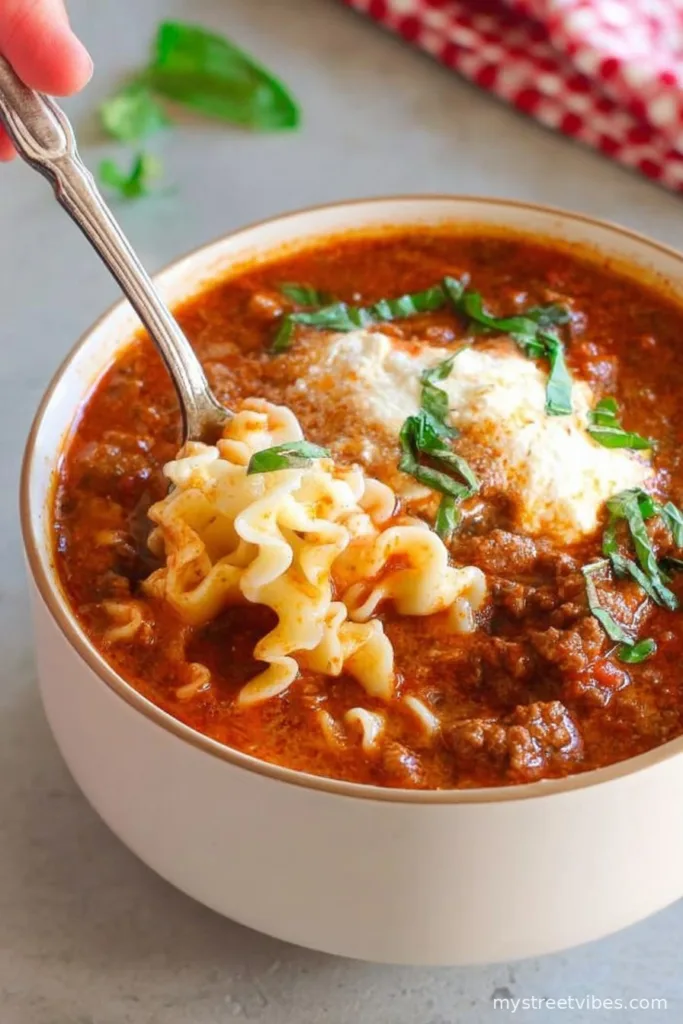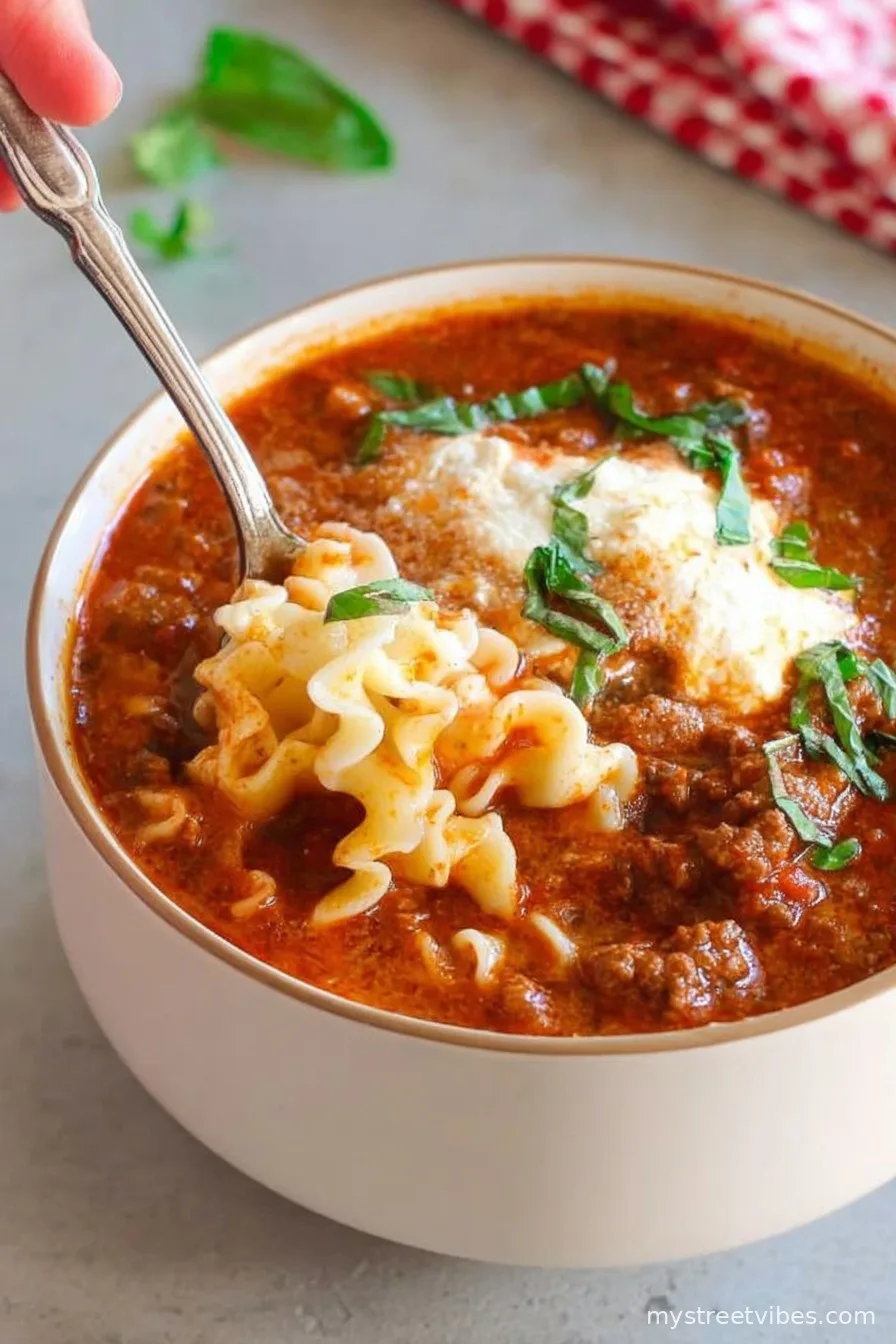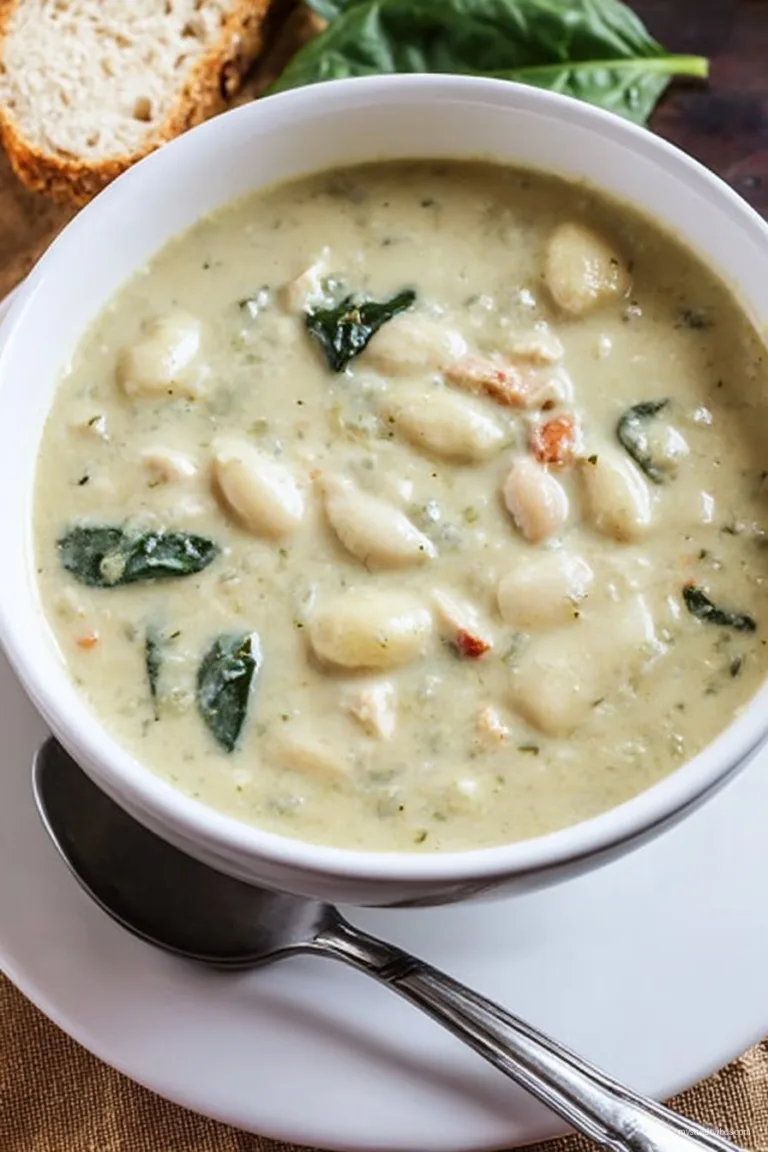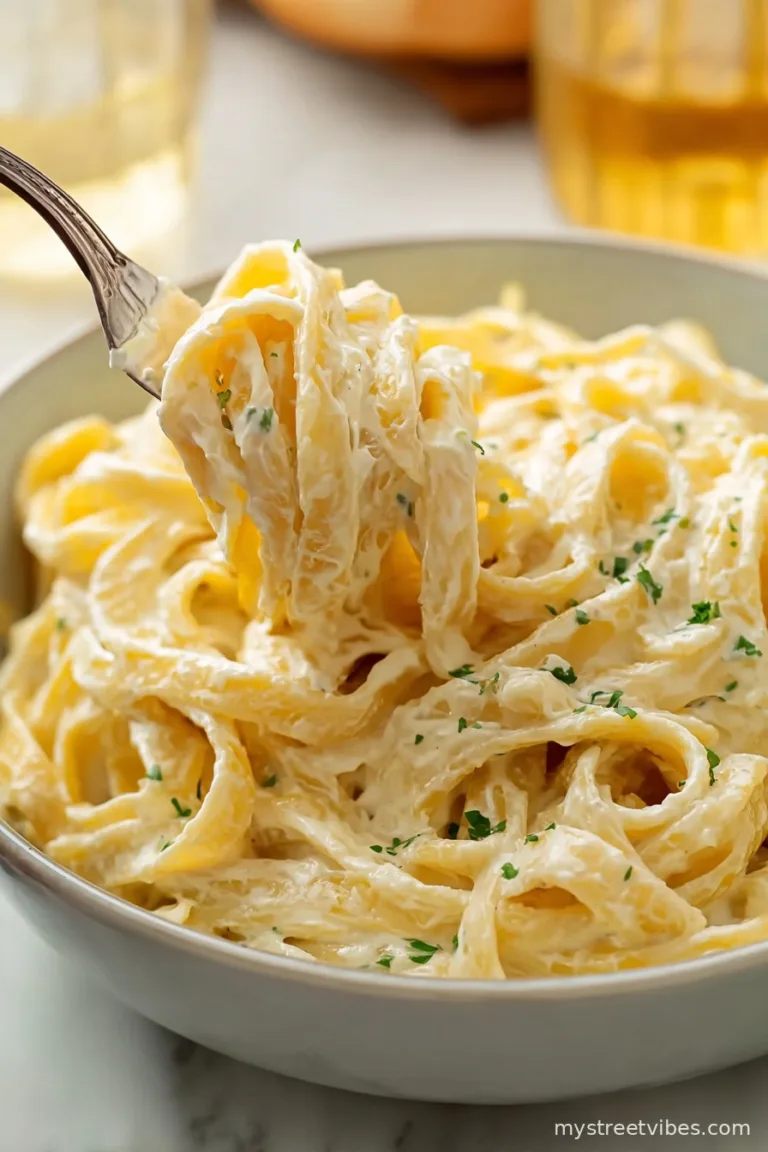If You Like Lasagna (But Hate Layering), This Soup’s for You
Okay, you know those days when lasagna just seems like way, way too much effort but you’re still dreaming about that gooey, cheesy goodness? That’s where lasagna soup saves the day (or the weeknight, anyway). Actually, the first time I made this, I was trying to re-create my aunt’s famous homestyle lasagna for a little get-together, but the pasta ripped in three spots and, let’s be real, I was cranky. So I went all “what if I just…threw it all in a pot?” No one complained. In fact, my cousin asked if I had a secret Italian grandmother hiding in the pantry—ha, I wish! Now it’s a family staple. Probably the only thing we all agree on besides how soccer should never be on TV during dinner.
Why You’ll Love Making Lasagna Soup (aka My Family’s Cold Day Favorite)
I make this when everyone’s a bit grouchy and it feels like the wind could knock you over. Or when I only have an hour (okay, like, 40 minutes if I really hustle) and still want that classic lasagna comfort but without the drama of perfect layers. My family goes crazy for this because it’s everything we love—tomatoey, cheesy, just the right amount of hearty. (Nobody misses the crispy top, which, frankly, I always burned anyway. Oops.)
Stuff You’ll Need (Swaps Welcome, Grandma Approved)
- 1 lb ground beef (I’ve used turkey or a mix of beef and Italian sausage—honestly, whatever’s on sale)
- 1 cup diced onion (yellow or white, or just more garlic if you, like me, forget to buy onions sometimes)
- 3 cloves garlic, minced (or two if you’re not as much of a garlic fan as me—can’t relate!)
- 1 red bell pepper, chopped (optional; my aunt leaves this out and it’s still tasty)
- 1 can (28 oz) crushed tomatoes (some folks get fussy about the brand—I just grab whatever, usually store-brand, sorry Grandma)
- 1 can (15 oz) tomato sauce
- 4 cups chicken or beef broth (or veggie broth, if you’re feeling virtuous)
- 1 tbsp Italian seasoning (or shake in some oregano and basil if that’s all you’ve got)
- A good pinch of red pepper flakes (optional; I usually forget, then add later on…and it wakes up the soup!)
- Salt and pepper, to taste
- 8 oz lasagna noodles, broken into chunks (if you only have penne or rotini, fine by me)
- 1 cup ricotta cheese (whole milk or part skim, I sometimes sub a big dollop of cottage cheese—shhh, don’t tell my mom)
- 1 cup shredded mozzarella (or more—I measure cheese with my heart)
- ½ cup grated parmesan
- Handful of fresh basil (if you wanna be fancy)
How To Make Lasagna Soup: Just Trust The Process
- Brown the meat. Grab a big pot or Dutch oven (mine’s a bit chipped, but it still works). Toss in your ground beef on medium heat. Brown it until it loses the weird pink look. If you’re using sausage, throw that in too. Drain off extra fat—unless you’re feeling wild, then don’t, no judgment.
- Veggie parade. Add onions, garlic, and bell pepper. Sauté until the onions look see-through. (This is where I usually sneak a taste. Don’t use the same spoon, though—learned that the hard way when I tried impressing my in-laws.)
- Sauce things up. Pour in crushed tomatoes, tomato sauce, broth; toss in Italian seasoning, red pepper flakes, salt, and pepper. Give everything a good stir. Bring to a low boil (it will smell amazing). Once it’s bubbling, turn it down so it just simmers. If it looks a bit thin, it’ll thicken up—promise.
- Noodle time. Break up lasagna noodles and toss ‘em in. (This part’s oddly satisfying.) Simmer uncovered 15-20 minutes, stirring now and then so you don’t end up with a weird noodle raft. Don’t worry if it looks a bit gloopy; it always does. Taste a noodle to check if it’s done—don’t burn your tongue (I do every time).
- Cheese explosion. Turn off heat. Dollop big spoonfuls of ricotta right into the pot, sprinkle in mozzarella and parmesan, and give it a brief stir. Or serve soup in bowls and let everyone add their own pile of cheese (much safer for cheese lovers, trust me). Fresh basil on top if you’ve got it.
Notes: Things I’ve Actually Learned Making This (No, Really)
- If you let it sit for like an hour after cooking, the noodles might soak up most of the broth and it’ll look almost like a stew. Just add more broth and it turns right back into soup. On second thought, some people actually like it thicker—pick your path.
- I’ve forgotten the bell pepper a dozen times, and nobody’s ever noticed.
- Sometimes I make the soup without the noodles, then boil pasta separately—helps if you plan to reheat leftovers (not that we ever have any, but you might).
- Don’t be shy with the cheese. Ever.
Variations: Experiments from My Kitchen (Some Worked, Some…Didn’t)
- I’ve swapped beef for ground turkey. Healthier? Maybe. Still delicious? For sure.
- I tried with gluten-free noodles once—either I botched it, or those noodles just aren’t my vibe. You could try it though…honestly, maybe a different pasta?
- Add extra veggies (zucchini, spinach, even mushrooms). It’s great, but my kids side-eye anything green so your mileage may vary.
- Once, I tossed in a splash of red wine while cooking the sauce. Highly recommend if you like a little depth (plus, you can take a cheeky sip while the soup simmers).
Equipment: Don’t Panic if You Don’t Have a Dutch Oven
I use a big ol’ Dutch oven, but honestly, any large soup pot will do. No need for fancy stuff. I once made this in a deep frying pan (not advised, way too splashy, but it technically worked in a pinch!). Wooden spoon, ladle, and a cheese grater if you’re grating parmesan yourself.
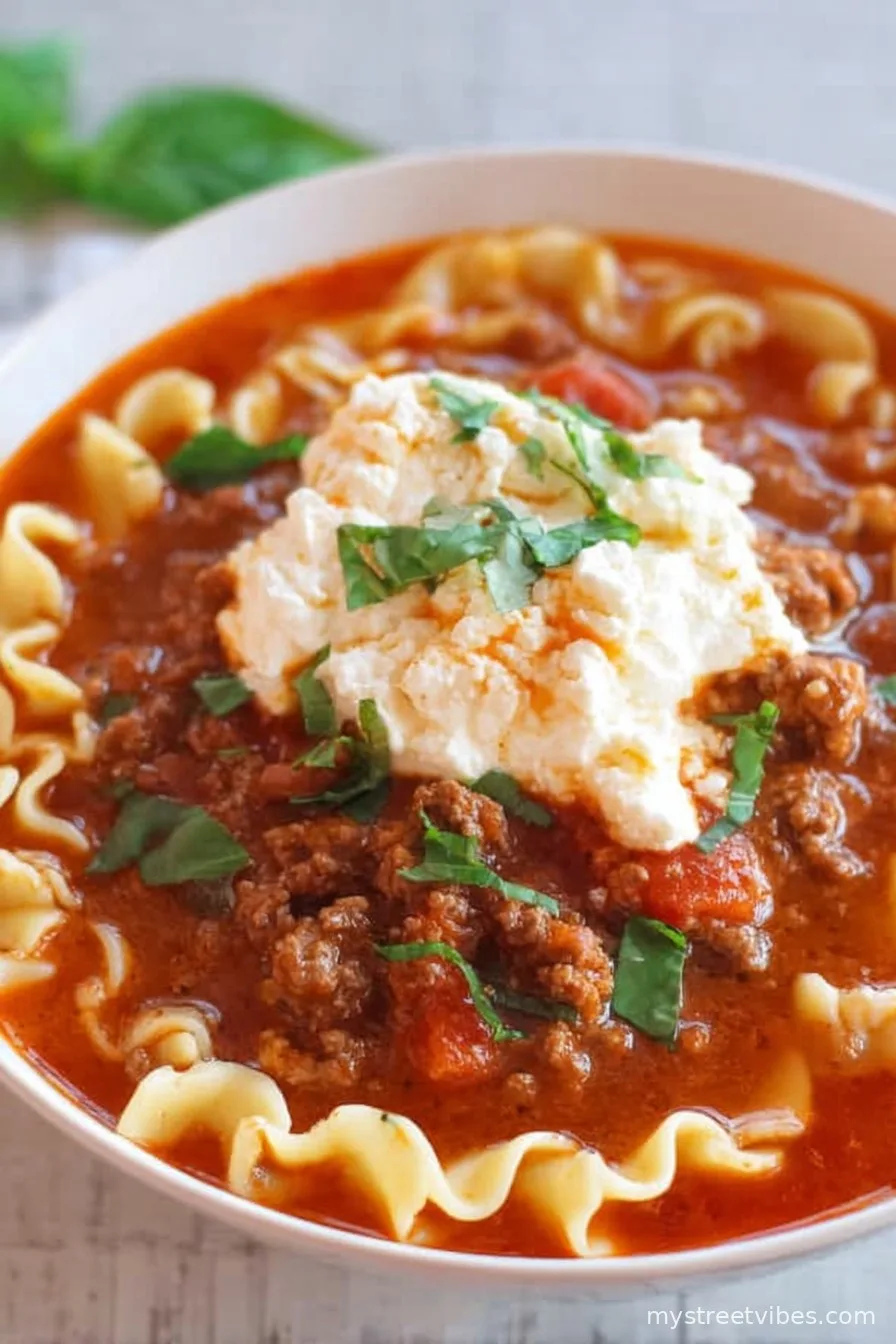
How To Store It (If It Sticks Around)
Officially, you can keep this in the fridge for 3 days, and I suppose it freezes fine if you leave the noodles out (they get a little mushy otherwise). But really—in my house, this pot’s empty by the next morning. If you do freeze it, scoop out soup minus noodles and add fresh ones when reheating; just learned that the hard way after a very weird, gluey mess. For more storage tips, see Serious Eats guide to soup storage.
How We Serve It (Bread Is Non-Negotiable)
I always serve this with a hunk of crusty bread. Sometimes garlic bread if I’m feeling extra, or just whatever loaf looks the best at the bakery—this is not a time for restraint, friends. My cousin swears by a squeeze of fresh lemon over the bowl, I think that’s just odd, but hey, maybe you’ll like it.
Learned The Hard Way: My So-Called Pro Tips
- I once tried rushing the simmering part because school pickup ran long. Noodles were chewy (not the good kind). Just let it simmer, even if you’re tempted to crank up the heat to speed through.
- Don’t add the cheese too early—it basically disappears and you’ll be left sad and cheeseless. Trust me. Wait till just before serving, or better yet, let everyone add their own.
- If it’s looking too thick, it’s probably because the noodles are drinking all the good stuff. Add more broth and you’re golden.
Real Questions, Real Answers (From Texts, DMs, and Awkward Potlucks)
- Can I make it ahead? Yeah, it’s even better the next day if you ask me. Just add more broth when reheating so it doesn’t turn into glue.
- Can I use a slow cooker? You technically can, but actually, I find it works better if you simmer it in a big pot. The noodles can get kinda weird in the slow cooker, too soft for my taste.
- Is this freezer friendly? Only if you leave out the noodles and add them fresh later—otherwise, everything just turns to mush, and not in a good way.
- What cheese works best? Mozzarella is classic, but I’ve used provolone or even cheddar when desperate. Use what you’ve got—cheese is cheese.
- I don’t eat beef, any subs? Try ground turkey, or even add in some lentils—just brown them up real good!
- Where’d you learn this? A bit form my aunt, a bit from the internet, and a lot of trial and error. I’m not exactly reinventing the wheel, but it sure tastes like home. If you want a fancier version with some bells and whistles, the folks at Bon Appétit have a jazzy recipe, too.
- Noodles first or last? I usually just toss them in halfway through, but honestly, you could boil them separately if you want more control over the soupiness.
- Why is my soup so thick? Probably the noodles’ fault—they soak up everything. Next time, save some broth for reheating, or just add water in a pinch. No shame in that game.
There you go. If you try it, let me know what you think, or, like, send a pic (I promise I won’t judge your cheese ratio). Oh, and if someone tells you it isn’t “real” lasagna, just nod and smile. This soup’s too tasty to argue about.
P.S. If you want to geek out on soup tricks, here’s some advice I found handy last winter.
Ingredients
- 1 tablespoon olive oil
- 1 pound ground beef
- 1 small onion, diced
- 3 cloves garlic, minced
- 1 teaspoon dried oregano
- 1/2 teaspoon dried basil
- 4 cups low-sodium chicken broth
- 1 can (28 ounces) crushed tomatoes
- 8 lasagna noodles, broken into pieces
- 1 cup ricotta cheese
- 1 cup shredded mozzarella cheese
- 1/4 cup grated Parmesan cheese
- Salt and pepper to taste
- Fresh basil, for garnish (optional)
Instructions
-
1Heat olive oil in a large pot over medium heat. Add ground beef and cook until browned, breaking it up with a spoon.
-
2Add diced onion and cook for 3-4 minutes until softened. Stir in minced garlic, oregano, and basil; cook for 1 minute until fragrant.
-
3Pour in chicken broth and crushed tomatoes. Bring to a boil, then reduce heat and simmer for 10 minutes.
-
4Add broken lasagna noodles to the pot. Simmer for 10-12 minutes, stirring occasionally, until noodles are cooked al dente.
-
5Season soup with salt and pepper to taste. Ladle into bowls and top with ricotta, mozzarella, and Parmesan cheeses. Garnish with fresh basil if desired.
Approximate Information for One Serving
Nutrition Disclaimers
Number of total servings shown is approximate. Actual number of servings will depend on your preferred portion sizes.
Nutritional values shown are general guidelines and reflect information for 1 serving using the ingredients listed, not including any optional ingredients. Actual macros may vary slightly depending on specific brands and types of ingredients used.
To determine the weight of one serving, prepare the recipe as instructed. Weigh the finished recipe, then divide the weight of the finished recipe (not including the weight of the container the food is in) by the desired number of servings. Result will be the weight of one serving.
Did you make this recipe?
Please consider Pinning it!!
